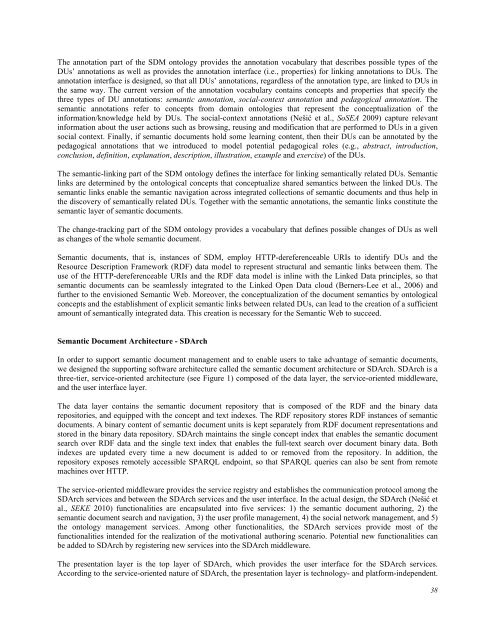October 2011 Volume 14 Number 4 - Educational Technology ...
October 2011 Volume 14 Number 4 - Educational Technology ...
October 2011 Volume 14 Number 4 - Educational Technology ...
Create successful ePaper yourself
Turn your PDF publications into a flip-book with our unique Google optimized e-Paper software.
The annotation part of the SDM ontology provides the annotation vocabulary that describes possible types of the<br />
DUs’ annotations as well as provides the annotation interface (i.e., properties) for linking annotations to DUs. The<br />
annotation interface is designed, so that all DUs’ annotations, regardless of the annotation type, are linked to DUs in<br />
the same way. The current version of the annotation vocabulary contains concepts and properties that specify the<br />
three types of DU annotations: semantic annotation, social-context annotation and pedagogical annotation. The<br />
semantic annotations refer to concepts from domain ontologies that represent the conceptualization of the<br />
information/knowledge held by DUs. The social-context annotations (Nešić et al., SoSEA 2009) capture relevant<br />
information about the user actions such as browsing, reusing and modification that are performed to DUs in a given<br />
social context. Finally, if semantic documents hold some learning content, then their DUs can be annotated by the<br />
pedagogical annotations that we introduced to model potential pedagogical roles (e.g., abstract, introduction,<br />
conclusion, definition, explanation, description, illustration, example and exercise) of the DUs.<br />
The semantic-linking part of the SDM ontology defines the interface for linking semantically related DUs. Semantic<br />
links are determined by the ontological concepts that conceptualize shared semantics between the linked DUs. The<br />
semantic links enable the semantic navigation across integrated collections of semantic documents and thus help in<br />
the discovery of semantically related DUs. Together with the semantic annotations, the semantic links constitute the<br />
semantic layer of semantic documents.<br />
The change-tracking part of the SDM ontology provides a vocabulary that defines possible changes of DUs as well<br />
as changes of the whole semantic document.<br />
Semantic documents, that is, instances of SDM, employ HTTP-dereferenceable URIs to identify DUs and the<br />
Resource Description Framework (RDF) data model to represent structural and semantic links between them. The<br />
use of the HTTP-dereferenceable URIs and the RDF data model is inline with the Linked Data principles, so that<br />
semantic documents can be seamlessly integrated to the Linked Open Data cloud (Berners-Lee et al., 2006) and<br />
further to the envisioned Semantic Web. Moreover, the conceptualization of the document semantics by ontological<br />
concepts and the establishment of explicit semantic links between related DUs, can lead to the creation of a sufficient<br />
amount of semantically integrated data. This creation is necessary for the Semantic Web to succeed.<br />
Semantic Document Architecture - SDArch<br />
In order to support semantic document management and to enable users to take advantage of semantic documents,<br />
we designed the supporting software architecture called the semantic document architecture or SDArch. SDArch is a<br />
three-tier, service-oriented architecture (see Figure 1) composed of the data layer, the service-oriented middleware,<br />
and the user interface layer.<br />
The data layer contains the semantic document repository that is composed of the RDF and the binary data<br />
repositories, and equipped with the concept and text indexes. The RDF repository stores RDF instances of semantic<br />
documents. A binary content of semantic document units is kept separately from RDF document representations and<br />
stored in the binary data repository. SDArch maintains the single concept index that enables the semantic document<br />
search over RDF data and the single text index that enables the full-text search over document binary data. Both<br />
indexes are updated every time a new document is added to or removed from the repository. In addition, the<br />
repository exposes remotely accessible SPARQL endpoint, so that SPARQL queries can also be sent from remote<br />
machines over HTTP.<br />
The service-oriented middleware provides the service registry and establishes the communication protocol among the<br />
SDArch services and between the SDArch services and the user interface. In the actual design, the SDArch (Nešić et<br />
al., SEKE 2010) functionalities are encapsulated into five services: 1) the semantic document authoring, 2) the<br />
semantic document search and navigation, 3) the user profile management, 4) the social network management, and 5)<br />
the ontology management services. Among other functionalities, the SDArch services provide most of the<br />
functionalities intended for the realization of the motivational authoring scenario. Potential new functionalities can<br />
be added to SDArch by registering new services into the SDArch middleware.<br />
The presentation layer is the top layer of SDArch, which provides the user interface for the SDArch services.<br />
According to the service-oriented nature of SDArch, the presentation layer is technology- and platform-independent.<br />
38

















